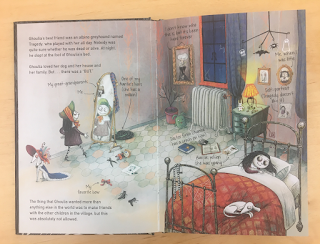Today’s guest contributor, Meagan Albright, is a Youth Services Librarian III at the NSU Alvin Sherman Library, Research and Information Technology Center in Fort Lauderdale, FL. She served on a variety of ALSC Committees, including the 2018 Theodor Seuss Geisel Award Selection Committee and the 2012 Notable Children’s Books Committee. Meagan’s current work philosophy is inspired by Doctor Who: “We’re all stories in the end. Just make it a good one.”
 Ghoulia welcomes newly independent readers with strong, simple sentences in a large “handwritten” font that introduces the characters and the hook of the book (zombie seeking friendship) on pages with limited text and plenty of white (well… black or orange) space on the page. However, the layout of the text on the pages is potentially confusing for some readers, who may be unsure if the sentence should be read straight across or page-by-page.
Ghoulia welcomes newly independent readers with strong, simple sentences in a large “handwritten” font that introduces the characters and the hook of the book (zombie seeking friendship) on pages with limited text and plenty of white (well… black or orange) space on the page. However, the layout of the text on the pages is potentially confusing for some readers, who may be unsure if the sentence should be read straight across or page-by-page.
On subsequent pages, readers find a shift in both the font and style, with longer text blocks and more challenging vocabulary. Engaging illustrations and a sufficient use of white space around these text blocks lend a page-turning dynamic that encourages readers and propels them through the story. The problem of confusing text placement, however, recurs throughout the book.
 |
| Images provided by Meagan Albright |
For example, on this double-page spread, it is tempting for readers to follow the visual cue of leaves across the pages, but the flow of the story clearly works better if readers finish the text on the page first before moving to the second page in the spread.
Occasionally problematic text placement aside, Ghoulia has many positive qualities. The concepts of diversity, acceptance and friendship are clearly conveyed, and the witty tone keeps these lessons from feeling didactic. The spooky tone and subject matter make the book an obvious choice for Halloween, but the (as Booklist describes it) “charmingly morbid” new series will appeal to readers year-round.
While Ghoulia is without a doubt an engaging, humorous and delightful book, this year’s Geisel committee will have to decide if it rises to the level of distinguished and fully meets the award’s criteria. For readers at the younger end of the award’s spectrum (which is pre-K through Grade 2), Ghoulia may serve best as a shared, rather than independent, reading experience. The book features difficult vocabulary (venture, waltzed, forbade, furious, misfortune) that is not always explicitly explained by the illustrations and these new words are not consistently repeated enough to ensure knowledge retention. Dense blocks of text may prove intimidating, and the charming labels and asides contained in the illustrations result in the occasional unusual text placement on the page.
Though Ghoulia does not make my personal list for the 2019 Theodor Seuss Geisel Award, I know the book will find many young readers who are delighted by this witty, engaging, faux-dark tale.




No comments:
Post a Comment
Note: Only a member of this blog may post a comment.